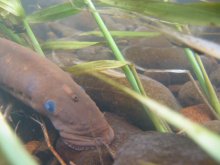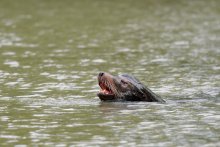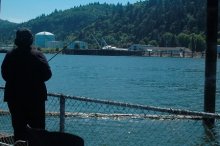Portland Harbor
Hazardous Waste Site | Portland, Oregon | 1900s to Present
What Happened?
Since the early 1900s, numerous facilities have released oil, PCBs polychlorinated biphenyls; a class of chemicals previously used in manufacturing that remain in the environment for many decades, accumulate in living creatures, and pose health hazards to humans, wildlife, and fish., heavy metals, pesticides, and other hazardous substances into Portland Harbor. This highly industrialized area of the Willamette River continues to serve as a hub for the commercial shipping industry.
EPAU.S. Environmental Protection Agency; federal agency with the mission to protect human health and safeguard the environment. designated the area a Superfund siteAn uncontrolled or abandoned place where hazardous waste is located, possibly affecting local ecosystems or people. Sites are listed on the National Priorities List for evaluation and cleanup by the U.S. Environmental Protection Agency. in 2000. Portions of the contaminated area have been cleaned up, and planning for a large-scale cleanup is underway. NOAA has been providing technical assistance to EPA throughout this process.
What Were the Impacts?
- Contaminants in Portland Harbor have accumulated in sediments at potentially hazardous levels within an 11-mile stretch of the lower Willamette River and adjacent floodplains.
- Salmon and lamprey, as well as fish-eating birds (eagles, osprey) and mammals (including mink), have been exposed to these contaminants and may have been injured.
- Resident fish in the lower Willamette River contain elevated levels of PCBs and mercury. Health advisories restricting fish consumption are in effect.
What’s Happening Now?
-
NOAA and other Trustee Council members have been conducting a Natural Resource Damage Assessment (NRDA) since 2010 for the Portland Harbor site, to evaluate natural resource injuries incurred over time in areas contaminated with hazardous substances (such as DDT, PCBs, and others), and oil.
-
As part of the NRDA process, separate from the EPA cleanup process, NOAA and its co-trustees are conducting an injury assessment at the site.
-
The scope of the NRDA includes impacts to natural resources such as fish, wildlife, and other organisms impacted by pollution—and the lost services related to those resources, including recreational fishing and tribal uses.
-
In August 2020, the Trustee Council released a Draft Supplemental Restoration Plan and Environmental Assessment. The Plan proposed purchasing credits from restoration banks as the Preferred Alternative for the current phase of restoration and it evaluates the potential environmental impacts of all the alternatives, consistent with the National Environmental Policy Act.
-
In March 2021, the Trustees finalized the draft supplemental plan which selects purchasing credits from restoration banking projects as the way that the Trustee Council will restore habitat during the current phase of restoration. Eligible restoration bank projects include:
-
Alder Creek Restoration Project: Restored and enhanced 52 acres to improve habitat at a former industrial site.
-
Harborton Habitat Development Project: Restored tributary and off-channel habitat across 53 acres of the Portland General Electric Harborton Substation property.
-
Linnton Mill Restoration Site: Restored 27 acres of an industrial site into a landscape with rehabilitated riparian and upland habitat, new off-channel habitat, and enhanced shallow-water and active channel margin habitats.
-
Miller Creek Restoration Project: Will reconnect Miller Creek to Multnomah Channel to enhance 13 acres of habitat near the confluence of the Multnomah Channel and the Willamette River.
-
Rinearson Natural Area -This project restored 33 acres of floodplain and channel habitat, including improving fish passage at a former dam.
-
-
On November 1, 2023, the U.S. Department of Justice (DOJ) announced a proposed settlement valued at approximately $33 million to compensate for natural resource injuries that resulted from hazardous substance releases and oil discharges into the Willamette River and Portland Harbor. The settlement would resolve the liability of more than 20 potentially responsible parties for damages to natural resources, loss of recreational services and tribal uses, as well as the cost of assessing those injuries.
The settlement was open for a public comment period until January 28, 2024. Additional information is available on the Portland Harbor Natural Resource Trustee Council website.
"Since time immemorial we, the River People, have harvested fish in the waters of the Willamette and the Columbia. Polluted moribund waters cannot give life to the salmon and without that we, the River People, cannot live."
Chairman Austin Greene, Confederated Tribes of the Warm Springs Reservation of Oregon
Contacts
Troy BakerNOAA Office of Response and RestorationSeattle, WA(206) 639-8303troy.baker@noaa.gov










